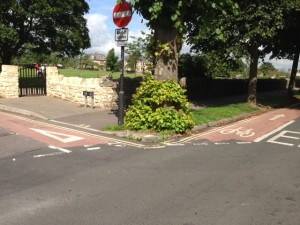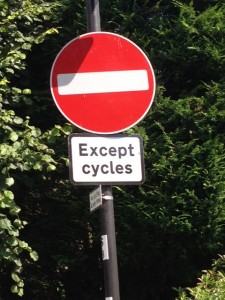One of the comments so far in response to my post about the cycle contraflow in Cheap Street/Westgate Street (I still don’t know if/when it will be completed, but I am inquiring), is about making the contraflows clearer by painting the lanes on the road. There are all sorts of difficulties connected to doing this in the city centre, but elsewhere it can work. After all the London “superhighways” for cyclists are painted blue. The photo of The Avenue and The Firs contraflows in Combe Down (where else?) shows how a little paint can work really well.
There is paint only at the beginning and end of the roads. Traffic is not heavy on either road, so a light touch here is fine. These contraflows are cheap to install, people on bikes no longer ride on pavements in these roads and the contraflows slow motor vehicles down as a bike approaches.
Whatever the type of implementation; and I think it should be horses for courses, with physical barriers between cycles and motor vehicles as the first option on busy roads. In my view all one way streets should be contraflows for bikes as this shortens journey times and keeps cyclists away from time consuming, dangerous one way systems. This is a way of encouraging people to ride bikes. Contraflows can make the journey shorter, safer and more direct.
I welcome any views on this issue and perhaps information as to where there is a need for contraflows. Please comment if you wish.



 Hello, I'm Roger Symonds and I have created this blog to highlight local and wider cycling issues. Given the incredible interest and increase in cycling we must not miss this opportunity to provide the the infrastructure that gets even more people out on bikes in a safer environment.
Hello, I'm Roger Symonds and I have created this blog to highlight local and wider cycling issues. Given the incredible interest and increase in cycling we must not miss this opportunity to provide the the infrastructure that gets even more people out on bikes in a safer environment.
I quite like a bit of colour on the cycle path – makes people take notice a little bit more…whether they are needed for properly segregated paths I’m not sure, but at least pedestrians are slightly less likely to wander in them
Hi Jason
Yes I agree, but probably not needed for segregated paths. Council’s try to reduce maintenance as much as possible, so you will see lots of lines needing repainting as they are being worn away. They will get there is the end, but it takes longer to renew the painting now.
Thanks for your comment.
Roger
Prefferable to paint (which can be low traction, especially in wet weather) is proper coloured tarmac.
Regardless, something that annoys me is that there’s no standard for what colour a painted cycle lane should be. Some councils use red, some green, London’s “Cycle Superhighways” are blue thanks to corporate branding. An actual national standard- be it red or green- would be a sensible thing to implement. I’d suggest green- and standardise bus lanes (which are also both found as red or green) as red.
Hi Al
Thanks for comment. Thanks for putting me right on this. Coloured tarmac is better than paint, but more expensive. I agree that there should be a standardized colour and i too would faviour green. I assume that we use red paint in B&NES, but I would like to find out why and who has decided the colour.
Coloured tarmac would also imply new surface which would be fantastic because some of the roads in Bath are hazardous for road bikes. Point taken about cost though.
I’m not saying that we shouldn’t do it. All depends on priorities. If bikes are important then money can be made available. The Council takes a modern attitude towards road surfacing in managing the asset. This means not just repairing potholes but resurfacing where roads will soon need some attention.
The Dutch use coloured tarmac, rather than paint. Looks better, lasts longer..
http://www.aviewfromthecyclepath.com/2011/06/rolling-out-red-carpet-for-cyclists.html
Hi Fred
Thanks, this has been pointed out to me by a number of people. And thanks for sending the link to David Hembrow’s site. We haven’t got any cycle lanes on main roads, but coloured tarmac is the way to go.
large circular blue painted dots with a bike in white every 10/20 metres? liking the two t’s info direction panels on the ground,which is a step forward but guess not standard counrtywide practice
I haven’t seen these. Are they in Westgate Street?
I would love to see some coloured cycle lanes. How about turning one half of the ‘motorway’ on Rossiter Road into one of these for instance? 😉 I feel particularly unsafe cycling along there every day.
I’ve been spoiled by having lived in Muenster/Germany for 3 years where this is standard. It’s the most bike-friendly town I’ve ever been to, I especially love the bike-traffic lights where at any big junction bikes get green first which means they can clear the junction safely before any cars get onto it.
Hi Andrea
Yes it makes sense to have a cycle lane on Rossiter Road. The whole area is subject to £1.8m of changes, but sadly most of this will be spent on getting vehicles through Rossiter Road and not on Widcombe Parade. Stubbornly officers are still designing to 40mph, when 30mph is perfectly adequate. Much work still to be done on developing a cycling culture in the Council. Cyclists are active in trying to get good facilities here. Nigel Sherwen nigelsherwen@tiscali.co.uk is inputting for cyclists and the Widcombe Assn. are trying to get a better scheme.
I’m sorry to hear that there are plans to make this area 40mph, this is the school route for a lot of primary school children (Widcombe Infants and Juniors), wouldn’t it be nice if they could safely cycle along there instead of being taken by car? I’m sure that would reduce the traffic around there a lot as well as can already be seen during school holidays.
Yes that is right, but I’m afraid that common sense about the engineering on Rossiter Road seems to have flown out the window. We should try to get the best for cycling that we can get, especially to and from the Churchill Bridge. I shall do all I can to influence this.
I have just returned from a cycle ride to Brighton with my 10-year-old son. We aimed to follow NCN routes as far as possible and found that these were often fragmented and sometimes just disappeared. However, on the south coast there are long stretches where the cycle lane is clearly designated with green paint or tarmac (not sure which). This made for a safe and smooth cycling surface and seemed to deter wandering pedestrians more effectively than a simple outline. I agree that a standard colour nationwide would be desirable: we need to instill a culture of acceptance of cycling in this country in the way they have in mainland Europe, so that everyone is used to making way for cyclists and recognises cycle lanes as something to be respected and not obstructed.
Hello Brian
Thank you for adding to this debate about cycle lanes. I have cycled in Brighton, mainly along the sea front, which as you know has segregated lanes and is good for cyclists. NCN routes are mixed and some do just disappear. We have just returned from 3 days cycling in Cornwall using mainly NCN Route 3. This route is well signposted. I suppose my issue with the Sustrans routes is that the signs don’t give much information and I don’t like those that say “10 minutes cycling”. Distances would be much better, as we all cycle at different speeds and this makes no allowance for gradients.
I’m not sure whether local councils put up the signs or whether Sustrans put them in place. Perhaps someone can enlighten us. Having said all this it is great to have national routes that are signed specially for cyclists.
I would like to see a nationally agreed colour for bike lanes and I am in favour of green – it gives all the right positive messages. We have a long way to go with the cultural issue, but it is encouraging that there seem to be moves by Government to use more punitive sentences for drivers who kill or maim people riding bikes. The All Party Parliamentary Group Report is being debated in Westminster next week too.
Many thanks
When I was a Sustrans Ranger I did the initial temporary signing of the Colliers’ Way from Dundas to Frome. The small blue NCN stickers and nail-on plastic signs are supplied by Sustrans and affixed to Local Authority street furniture (on the highway sections with, allegedly, LA permission) are meant to be only temporary until the Local Authority supply and fix permanent signs. From memory it was only about six or seven years between the Colliers Way route opening and the council supplied signs appearing.
Hi Nigel
Thanks for this information. Some of the stickers on posts are still in place on route 3 and are very useful. The small blue signs are easy to pick out, but could give more information. The Two Tunnels is now well signed from Lr Bristol Road in Bath. That was done pretty quickly. Sustrans and the Council now have an MoU so perhaps the duties of both are spelled out in it – er.. I think it has been signed by now – B&NES were being slow to sign. I will check with Jon Usher when I see him at the Two Tunnels Group meeting next week.
Signing is a bit of a black art – it’s quite tricky to get right, and there’s a huge amount of detail to collect in preparation for signing. In most circumstances, Local Authorities simply won’t take responsibility for signing the National Cycle Network and the route ends up being signed with the temporary volunteer signs. Which become permanent features on routes up and down the country. In the case of the Two Tunnels, and as prescribed by our standard MoU, it is the responsibility of the delivery agent (in this case Sustrans) to sign the route. However, we don’t have the authority to place signs on the highway without the Highway Authority’s permission. This gets even more complicated when new posts are needed at junctions.
In the case of the two projects currently at the design stage in Bath this year, Bellotts Road Bridge and the crossing of the Lower Bristol Road, the Local Authority is the delivery agent and therefore has the responsibility to sign the route.
Just a quick note about the coloured surfacing discussed above, there are essentially three types: coloured tarmac; coloured high friction surfacing and coloured slurry seal.
Coloured tarmac provides the most durable, smooth surface. However, it needs special stone (red or green – and the green doesn’t come in a type suitable for use on the highway as far as I know), and a colourless binder. This means specially cleaned machinery needs to be brought in for the job to stop the job being spoiled with the tar normally used to bind the stone together.
Coloured high friction surfacing is currently the most popular solution in our area, its applied with a resin, then the coloured surface spread across the top. It costs about £13-15/m2, so it’s not cheap, and it tends to wear out, and then there’s never any money to replace it. Someone once told me that there’s approx £2million worth of coloured high friction surfacing on bus and cycle lanes across Bristol, and no strategy as to how to deal with its replacement.
Slurry seal is simply a coloured resin (with some grit to provide skid resistance). This is the type used for the Cycle Super Highways in London and it can be slipperier than the other two above, but gives a more vibrant colour. I’ve never used it, so don’t know how long it lasts compared to the other two.
Interestingly, there’s no regulation on colours used on the public highway despite our maddening regulatory framework for lines and signs. So Bath could go pink if it wanted!
John many thanks for this comment. It’s good to get clarity on signage and paint from an expert. I think the signage for Two Tunnels from Lr Bristol Road is pretty good – its temporary until Bellotts Road Bridge opens and the connection is made with the Railway Path.
I think the mixed commitment of local authorities to signing the cycle network is another illustration of Dept for Transport’s attitude towards cycling. It would surely be easy for them to put out some guidance for councils about their duties in this area. The coloured surfaces call out for some revenue funding to put them in and to maintain them, just as there is for normal road surfacing.
Has Sustrans lobbied Government to instruct local authorities on signage and coloured surface funding?